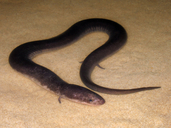|
Amphiuma tridactylum Cuvier, 1827
Three-toed Amphiuma, Conger Eel, Congo Eel, Congo Snake, Lamprey Eel, Ditch Eel, Fish Eel | family: Amphiumidae genus: Amphiuma |
| Species Description: Cuvier, G. L. C. F. D. 1827. Sur le genre de reptiles batraciens, Nomme Amphiuma, et sur une nouvelle espèce de ce genre (Amphiuma tridactylum). Mémoires du Muséum d'Histoire Naturelle. Paris 14: 1–14, 1 pl.. | |
 © 2008 Brad Moon (1 of 8) |
|
|
|
Description Amphiuma tridactylum, as the name suggests, has three toes on each foot. Coloration of this species is more distinctly bicolored than other amphiumas. The dorsum is black, slate gray, or brownish, while the venter is light gray. A dark patch is present on the chin and throat region. Adults reach 46 to 106 cm total length, with 57 to 60 costal grooves. The tail is laterally compressed and comprises about 25% of the total length (Salthe 1973; Petranka 1998). The three species of Amphiuma are similar but can be differentiated based on the number of toes (one, two, or three), coloration, and body size. Distribution and Habitat Country distribution from AmphibiaWeb's database: United States U.S. state distribution from AmphibiaWeb's database: Alabama, Arkansas, Kentucky, Louisiana, Missouri, Mississippi, Oklahoma, Tennessee, Texas
Life History, Abundance, Activity, and Special Behaviors Males reproduce annually, while females likely reproduce biannually. Females lay from 42 - 131 (mean 98) eggs, and brood the eggs until hatching. Nests of A. tridactylum have been found under logs and other cover objects at the edges of ponds and swamps. Hatching occurs in the late summer to late autumn, after a 4-5 month developmental period. See Petranka (1998) and references therein. Animals are active primarily at night, retreating to burrows during the day. Some animals forage by sticking only the head and upper body from the burrow. Diet items include crayfish and earthworms primarily, but also fish, spiders, snails, and aquatic and terrestrial insects. Predators include cottonmouth (Agkistrodon), and mudsnakes (Farancia). Amphiumas are capable of delivering a powerful bite, and this is their main defense against predators and people. During dry periods and droughts amphiumas can remain in their burrows for many months without feeding. Animals will also move overland during extremely wet periods. Three-toed amphiumas are locally common in many areas. See Petranka (1998) for references. Three-toed amphiumas are likely to play the role of top predator in many aquatic systems. The degree to which they affect community structure is not known and would be a productive area of investigation, particularly because the wetland habitats where they occur are threatened with continuing loss (Petranka 1998). Larva Trends and Threats Comments
References
Baker, C. L., Baker, L. C. and Caldwell, M. F. (1947). ''Observation of copulation in Amphiuma tridactylum.'' Journal of the Tennessee Academy of Science, 22, 87-88. Karlin, A. A., and Means, D. B. (1994). ''Genetic variation in the aquatic salamander genus Amphiuma.'' American Midland Naturalist, 132, 1-9. Petranka, J. W. (1998). Salamanders of the United States and Canada. Smithsonian Institution Press, Washington D.C. and London. Salthe, S. N. (1973). ''Amphiuma tridactylum Cuvier. Three-toed Congo Eel.'' Catalogue of American Amphibians and Reptiles. Society for the Study of Amphibians and Reptiles, 149.1-149.3. Salthe, S. N. (1973). ''Amphiumidae. Amphiuma.'' Catalogue of American Amphibians and Reptiles. Society for the Study of Amphibians and Reptiles, 147.1-147.4. Originally submitted by: Meredith J. Mahoney (first posted 2000-01-17) Edited by: M. J. Mahoney, Michelle S. Koo (2022-08-18) Species Account Citation: AmphibiaWeb 2022 Amphiuma tridactylum: Three-toed Amphiuma <https://amphibiaweb.org/species/3855> University of California, Berkeley, CA, USA. Accessed Jun 3, 2025.
Feedback or comments about this page.
Citation: AmphibiaWeb. 2025. <https://amphibiaweb.org> University of California, Berkeley, CA, USA. Accessed 3 Jun 2025. AmphibiaWeb's policy on data use. |




 Raffaëlli Account
Raffaëlli Account Map of Life
Map of Life